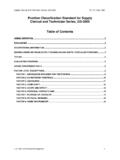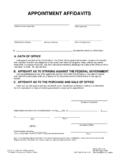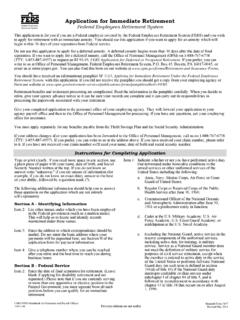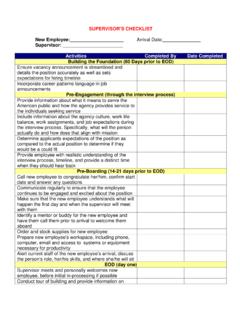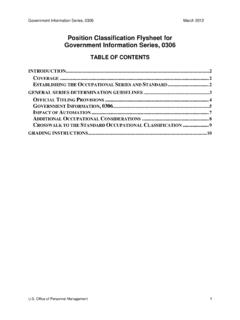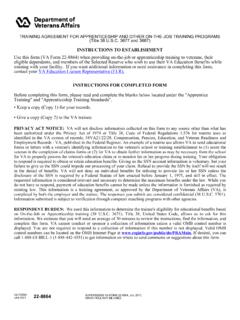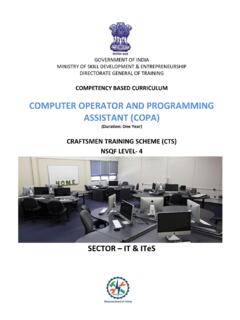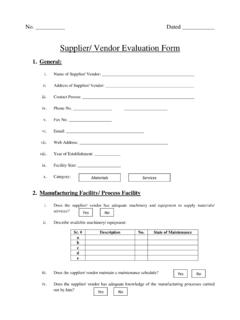Transcription of Position Classification Flysheet for Training Instruction ...
1 Training Instruction Series, GS-1712 TS-104 May 1991 Position Classification Flysheet for Training Instruction Series, GS-1712 Table of Contents SERIES OCCUPATIONAL EVALUATING Office of Personnel Management 1 Training Instruction Series, GS-1712 TS-104 May 1991 SERIES DEFINITION This series covers positions concerned with administration, supervision, Training program development, evaluation, or Instruction in a program of Training when the paramount requirement of the work is a combination of practical knowledge of the methods and techniques of Instruction and practical knowledge of the subject-matter being taught. Positions in this series do not have either a paramount requirement of professional knowledge and Training in the field of education, or mastery of a trade, craft, or laboring occupation.
2 This supersedes the series coverage standard for the Training Instruction Series, GS-1712, published in February 1980 (TS-40). EXCLUSIONS 1. Classify education and Training positions that require professional knowledge of the field of education in the appropriate professional series in the GS-1700 Group. 2. Classify education and Training positions for which the paramount qualification requirements for the work and the career patterns are primarily in a subject-matter field, including instructors in college or equivalent level programs, in the appropriate subject-matter series. 3. Classify education and Training positions that primarily require full professional knowledge of a subject field not covered by an established series in the General Education and Training Series, GS-1701.
3 4. Classify positions that involve planning, administering, or evaluating programs designed to develop employees and manage learning in the organization in the Job Family Position Classification Standard for Administrative Work in the Human Resources Management Group, GS-0200. 5. Classify positions that primarily involve advising on and promoting apprenticeship Training for workers in industry in the apprenticeship and Training Series, GS-0243. 6. Classify positions that involve aid or technician support to instructional or other professional or specialist staff engaged in education and Training work in the Education and Training Technician Series, GS-1702. 7. Classify positions that require a paramount knowledge of the field of recreation to plan, organize, advise on, and administer recreation activities and programs, which may involve some Instruction of participants, in the Recreation Specialist Series, GS-0188.
4 Office of Personnel Management 2 Training Instruction Series, GS-1712 TS-104 May 1991 8. Classify positions that require knowledge of one or more of the arts to plan, supervise, administer, or carry out educational or recreational programs in the arts, including providing Instruction , in the Music Specialist Series, GS-1051, the Theater Specialist Series, GS-1054, or the Art Specialist Series, GS-1056, as appropriate. OCCUPATIONAL INFORMATION This series covers positions involved in the direct delivery of Instruction or Training services of a nonprofessional nature. It covers classroom instructors, supervisors, and managers in Government-operated Training programs. This series also covers nonprofessional Training program staff specialists engaged in course development, test development, or similar staff work.
5 Some positions are involved in Training in military or civilian occupational specialties such as radar or communications equipment operation. Other positions may involve Instruction in subjects not specifically related to developing occupational skills such as courses in security regulations or freedom-of-information procedures. Some positions in this series may be found in a secondary school setting ( , shop Training ) or in a comparable setting. Distinguishing Positions in This Series from Professional Positions in the Education Group, GS-1700 Positions in both this series and the professional series in this group involve career patterns that are primarily in the field of education and Training . The key difference is that positions in this series require a practical (but less than full professional) knowledge of education and Training .
6 A practical knowledge of Training enables the employee to apply the principles and techniques of education and to help students acquire specific skills or knowledge. It does not require a mastery of the underlying philosophy and theories of education in relation to the growth and development of the individual. This practical knowledge of Instruction techniques can normally be acquired by on-the-job Training combined with study and practice. This series includes a broad range of positions involving Instruction , or the administration, management, or development of programs of Instruction . A Position should be classified in this series if there is clear evidence that persons with Training experience and knowledge of the subject being taught could satisfactorily perform the duties of the Position .
7 Generally, teachers and administrators in elementary and secondary schools make professional judgments concerning the educational, cultural, and social development of students. Other kinds of positions are classified in the appropriate professional education series because the incumbents must make other similarly professional judgments to manage, develop, conduct, or evaluate an educational program. Positions should be classified in one of the professional series, rather than the Training Instruction Series, GS-1712, only if there is a clear evidence, based on a thorough job analysis, that satisfactory performance of the work requires a professional knowledge of education. Office of Personnel Management 3 Training Instruction Series, GS-1712 TS-104 May 1991 Distinguishing Positions in This Series from the Federal Wage System (FWS) Job of Training Leader Employees who regularly train three or more other workers in the nonsupervisory work of a trade, craft, or laboring occupation are covered by the Federal Wage System Job Grading Standard for Training Leader when the paramount knowledge required to do the Training work is knowledge of the trade, craft, or laboring occupation.
8 Employees who regularly train less than three other workers in such occupations are covered by the appropriate Federal Wage System job grading standard for the work performed. The Training work performed by Training leaders is designed to enhance the trainees' knowledge and skill in a "blue collar" occupation. The Training typically includes demonstration of proper techniques and methods of the work and evaluation of the trainees' progress under a formal Training program designed to update, extend, or improve workers' skills. The Training provided by Training leaders may also include both on-the-job and classroom Training as a part of a formal program to improve the trainees' knowledge and skills to any target level in a recognized trade or line or work, such as an apprenticeship Training program.
9 At the higher grade levels Training leaders may provide on-the-job and classroom Training in trade theory; foundation knowledge required for adjustment to future technological changes; safety practices; characteristics of materials; and the use of machinery, precision instruments, and tools related to the occupation. Training leaders may participate in the design of course outlines and Training aids by drawing upon their personal experiences and study of trade publications. They also adapt and revise daily lesson plans, develop and administer quizzes, evaluate trainees' progress, counsel students, and resolve informal complaints and minor disciplinary problems. By contrast, instructor positions do not have a paramount qualification requirement of knowledge of a trade, craft, or laboring occupation.
10 Instructors may teach specialized trade related courses such as electricity, surveying, aircraft fundamentals, or similar subjects using textbooks, manuals, and other reference materials in a classroom or laboratory setting. Such courses are typically highly structured, repetitive, and of short duration. The instructor is required neither to provide on-the-job Training , nor to demonstrate a broad range of trade skills, nor to possess full knowledge of the trade or laboring occupation being taught to the students. The instructor is required to possess a practical knowledge of the subject area being taught and a practical knowledge of the methods and techniques of Instruction . In borderline cases Classification decisions may be based on environmental indicators, such as working relationships with other positions in the organization, normal lines of career progression, equitable pay relationships with other positions in the immediate organization, and management's intent in creating the Position .
